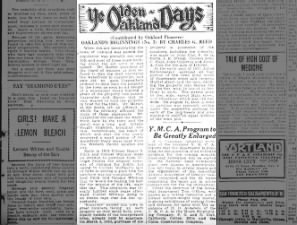Oakland Incorporation, Waterfront, Purchase, Subdivision - Ye Olden Oakland Days - Oakland Tribune - 31 Oct 1920, Sun - Page 45
 OAKLAND'S BEGINNINGS (No. 3) BY CHARLES G. REED
Ye Olden Oakland Days
TO BLOG Sun, Oct 31, 1920 – Page 45 · Oakland Tribune (Oakland, California) · Newspapers.com
OAKLAND'S BEGINNINGS (No. 3) BY CHARLES G. REED
Ye Olden Oakland Days
TO BLOG Sun, Oct 31, 1920 – Page 45 · Oakland Tribune (Oakland, California) · Newspapers.com(Contributed by Oakland Pioneers) OAKLAND'S BEGINNINGS (No. 3) BY CHARLES G. REED
When the act incorporating the town of Oakland was passed the population was probably not over 100, and most of these knew nothing about the act until it was passed. Mr. Marier, president of the board of trustees at first refused to sign the deed conveying the waterfront to Carpentier, and only did so upon Carpentier's promise to deed back the property to the town as soon as all danger of a subsequent board making a grant of the property had passed. Carpentier told Marier that he only wanted to hold the property in trust for the town. Mr. Marier, at his death, left an affidavit in which he solemnly affirmed the truth of these statements. Mr. Carpentier did not deed the waterfront back to the town and the result was a long and bitterly fought litigation, including certain compromises, the result of which was that the city finally recovered a small portion of the waterfront many years later when the Western Pacific entered the city.
Early in 1850 Colonel Henry S. Fitch and Colonel Whitney made an attempt to purchase from Vicente Peralta the original town site of Oakland for $8000, but owing to Colonel Whitney's lack of faith in setting a good title the purchase was not completed. Colonel Fitch told Colonel Whitney that he would die tearing his hair for the mistake of his life, made that day. This prediction was literally fulfilled some years afterward, Colonel Whitney dying in an insane rage over his lost opportunity. [I have searched in vain for a first name for Colonel Whitney. Do you know it? - MF]
"Squatters" poured into town in great numbers, taking up such property as they could hold, principally outside of the incorporated town, already held by squatters. On March 3, 1852, purchase of the property in possession of the squatters, including the townsite was made by John Clar, B. de la Barra, J. K. Irving, Colonel John C. Hays, John Caperton and Jacob A. Cost for the sum of $10,000.
In the early part of 1853 Julius Kellersberger surveyed all that portion of the town lying south of Fourteenth street and between Market Street and the lake, dividing the property into blocks 200 by 300 feet, with 28 lots of 30 feet front in each. The streets were 80 feet wide, except Main street, now Broadway, which was 110 feet wide. On August 16, 1853, a deed of partition was executed, setting apart the respective portions to each of the purchasers and also making to each an equal division of the town plot.

Comments
Post a Comment